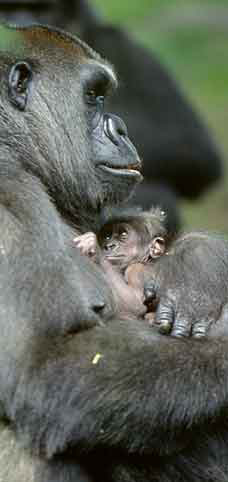Gorilla Born at Bronx Zoo
FIRST GORILLA BORN AT BRONX ZOO'S CONGO GORILLA FOREST HABITAT
 © Wildlife Conservation Society headquartered at the Bronx Zoo |
New York -- In the early hours on Monday, July 10th, the Bronx Zoo's first lowland gorilla baby was born in the Congo Gorilla Forest exhibit. Although the sex of the baby has not yet been determined, its name is Suki, which means "beloved." The honor was bestowed upon the youngster by Adam Pelzman and Andrea Stern Pelzman. Ms. Stern Pelzman is the daughter of Leonard Stern, whose wife Allison is a Trustee of the Wildlife Conservation Society. Suki's birth brings the number of gorillas born at the Bronx Zoo since 1972 to 45. The infant's mother Triska, whose name means 13, is the l3th offspring of Bendera, the Bronx Zoo's original breeding male gorilla. Suki's father, Timmy, never produced any offspring before arriving from Cleveland Metroparks Zoo in 1991, but now has sired 12 gorillas -- bringing his troop up to the magic number of 13! Triska was the first Bronx-born gorilla to reproduce; her other offsprings are Imani (female, born 1994) and Chipua (male, born 1996.) All can be seen at the Congo Gorilla Forest, a lush 6.5 acre tropical African rain forest habitat. General Curator James Doherty said, "We are truly delighted with this first gorilla birth at the Congo Gorilla Forest habitat. Since the exhibit's opening last June, all the species seem to have adjusted nicely to their spacious new surroundings." Doherty continued, "Triska and Suki's activities are being closely monitored by Mammal Department staff. The other gorilla group members are both welcoming and curious about the new addition." An endangered species, gorilla populations are declining because of habitat destruction. Often referred to as gentle giants, gorillas are generally docile, shy and peace-loving -- adult gorillas will often tolerate hours of playful antics from baby gorillas. Mature males can stand 6 feet tall and weigh 300-400 pounds; while females can stand 5 feet tall and weigh 150-300 pounds. Gorillas are vegetarians and their wild diet can include leaves, fruit, bark, stems, bamboo shoots, and other tough and chewy plant materials. At the Bronx Zoo, the gorillas eat vegetables (yam, carrot, celery, kale, collard greens, bok choy;) fruit (banana, apple, orange;) grains; prepared biscuits; and a commercially prepared diet. Under the auspices of the American Zoo and Aquarium Association (AZA,) the gorilla Species Survival Plan (SSP) was initiated in 1988. The Plan strives to optimize reproduction of the endangered western lowland gorilla within the protected confines of North American zoos. Its goal is to establish compatible social groups and to manage the population in order to maintain 90% of the original genetic diversity for 200 years. Fifty North American zoos and over 365 gorillas participate in the lowland gorilla SSP. WCS, headquartered at the Bronx Zoo, has been working in Africa for four decades to preserve rapidly vanishing wild lands. In 1959, WCS recognized the need to study gorilla behavior in nature and sent senior biologist, Dr. George Schaller to Rwanda and Zaire to begin a major study of gorillas. The Society continues to expand its commitment of staff and resources to the preservation of gorillas and their rapidly diminishing habitat. Zoo-goers to the Congo exhibit are asked to pay a $3 entry fee. As they explore the simulated African habitat they are encouraged to learn the basics of conservation -- to discover animal needs, involve local peoples, and protect wild places. At the end of this immersion experience, visitors are asked which WCS African project in the Congo rain forest their monies should be directed toward. Over $1 million has been raised since the exhibit's opening on June 24, 1999. Click here for visiting information and directions. The Wildlife Conservation Society (WCS) is dedicated to being the most effective conservation organization, protecting and promoting a world rich in wildlife and wilderness. WCS manages more than 300 field projects in 53 countries and develops award-winning environmental education programs for schools in the U.S. and abroad. At its celebrated wildlife parks in New York -- the Bronx Zoo, the New York Aquarium, and Central Park, Queens, and Prospect Park Wildlife Centers WCS inspires over 4.5 million annual visitors to care about wildlife and wild lands and to participate in their conservation. To learn more about WCS, visit www.wcs.org. |
